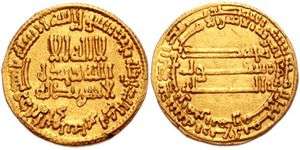Zubaidah bint Ja'far
Zubaidah bint Ja`far ibn Mansur (Arabic: زبيدة بنت جعفر ابن المنصور) (died 26 Jumada I 216 AH / 10 July 831 AD) was the best known of the Abbasid princesses, and the wife and double cousin of Harun ar-Rashid. She is particularly remembered for the series of wells, reservoirs and artificial pools that provided water for Muslim pilgrims along the route from Baghdad to Mecca and Medina, which was renamed the Darb Zubaidah[1][2][3] in her honor. The exploits of her and her husband, Harun al-Rashid, form part of the basis for The Thousand and One Nights.
| Zubaidah bint Ja`far ibn al-Mansur زبيدة بنت جعفر ابن المنصور | |||||
|---|---|---|---|---|---|
| Abbasid Princess | |||||
| Born | 766 Iraq | ||||
| Died | 10 July 831 Abbasid Empire | ||||
| Spouse | Harun al-Rashid | ||||
| Issue | Al-Amin | ||||
| |||||
| Dynasty | Abbasid | ||||
| Father | Ja`far ibn Al-Mansur | ||||
| Mother | Salsal (elder sister of al-Khayzuran) | ||||
| Religion | Islam | ||||
Biography
Zubaidah's birthdate is unknown; it is known that she was at least a year younger than Harun.[4] Her father, Ja'far was a half-brother of the Abbasid caliph al-Mahdi. Her mother, Salsal, was an elder sister of al-Khayzuran, second and most powerful wife of al-Mahdi, and mother of the future caliphs Musa al-Hadi and Harun al-Rashid.

Zubaidah is a pet name, given by her grandfather, caliph al-Mansur. The name means "little butter ball". Zubaidah's real name at birth was Sukhainah or Amat al-'Aziz".[4] Later, Zubaidah got a kunya, Umm Ja'far (meaning Mother of Ja'far),[5] which reflects her royal lineage as a granddaughter of caliph Abu Ja'far al-Mansur and a wife of caliph Abu Ja'far Harun al-Rashid.
She was the granddaughter of the Abbasid caliph Al-Mansur, through his son Ja'far, and cousin of al-Rashid (c.763 or 766-809), who she later married (Dhu al-Hijjah 165 AH/July 782 AD). The Abbasid caliph Muhammad al-Amin, who had a double royal lineage, was Zubaidah's son. Her stepson was 'Abdullah al-Ma'mun, who also became a caliph after the civil war with al-Amin.
It is said that Zubaidah's palace 'sounded like a beehive' because she employed one hundred women maids who had memorized the Qur'an.[6]
On her fifth pilgrimage to Mecca she saw that a drought had devastated the population and reduced the Zamzam Well to a trickle of water. She ordered the well to be deepened and spent over 2 million dinars improving the water supply of Makkah and the surrounding province. "This included the construction of an aqueduct from the spring of Hunayn, 95 kilometers to the east, as well as the famed “Spring of Zubayda” on the plain of Arafat, one of the ritual locations on the Hajj. When her engineers cautioned her about the expense, never mind the technical difficulties, she replied that she was determined to carry out the work “were every stroke of a pickax to cost a dinar,” according to Ibn Khallikan. "[7]
Ibn Battuta, referring to Zubaidah, states that "every reservoir, pool or well on this road which goes from Mecca to Baghdad is due to her munificient bounty...had it not been for her concern on behalf of this road, it would not be usable by anyone." He specifically mentions the water reservoirs at Birkat al-Marjum and al-Qarurah.[8]
Caliphs related to her
The Caliphs who were related to her are:
| No. | Caliph | Relation |
|---|---|---|
| 1 | Al-Mansur | Grandfather |
| 2 | Al-Mahdi | Uncle and Father-in-law |
| 3 | Al-Hadi | Cousin |
| 4 | Harun al-Rashid | Husband |
| 5 | Al-Ma'mun | Step-sons |
| 6 | Al-Mu'tasim | |
| 7 | Al-Amin | Son |
| 8 | Al-Wathiq | Step-grandsons |
| 9 | Al-Mutawakkil |
References
- Safadi. XIV. pp. 176–8.
- al-Baghdadi, Al-Khatib. Tarikh Baghdad. xtv. pp. 433–4.
- Bidaya. X. p. 271.
- Abbot, Nabia. Two Queens of Baghdad. p. 30.
- Abbot, Nabia. Two Queens of Baghdad. p. 150.
- Ibn Khallikan. I. p. 533.
- Verde, Tom. 2016. "Malik I: Khayzuran & Zubayda". Saudi Aramco World. January–February 2016. Vol. 67, no. 1, page 45.
- Battutah, Ibn (2002). The Travels of Ibn Battutah. London: Picador. pp. 52–54. ISBN 9780330418799.